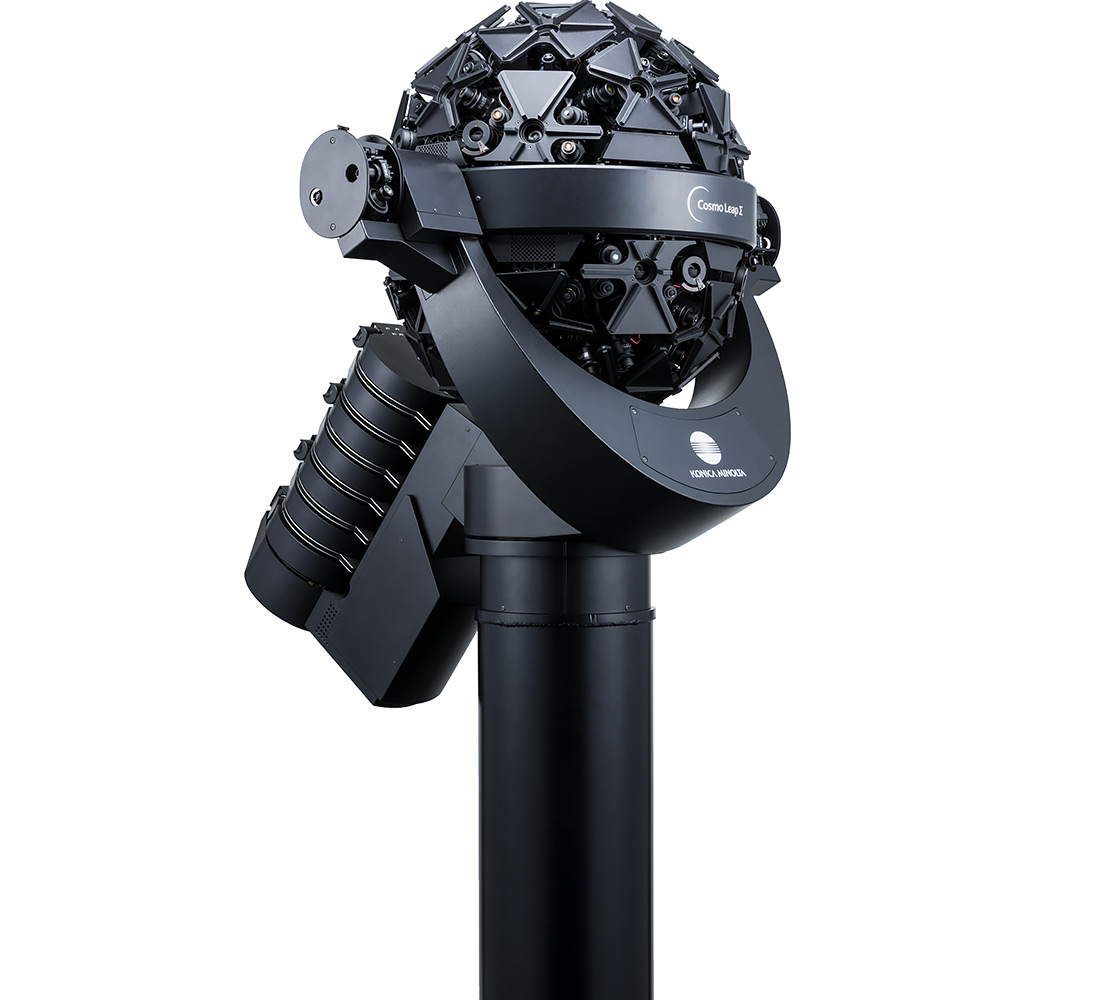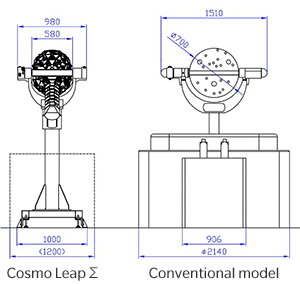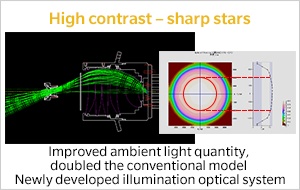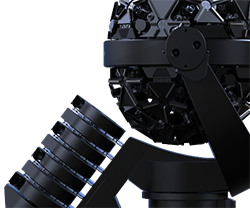
Cosmo Leap Σ
The Cosmo Leap Σ can project the starry sky equivalent to those of the Infinium Σ (Konica Minolta’s flagship optical planetarium that was developed to project beautiful fixed stars shining in the dark night sky) in small and medium-sized domes with an energy-efficient compact design.
Japan is the second most planetarium installed country after the United States of America. It has over 300 facilities and 75% of them are installed by governing bodies, mostly in medium-sized domes ranging approximately 10m in diameter.
In these small and medium-sized domes, Cosmo Leap Σ achieves sharp stellar images with various constellation images and realistic projections of variable stars (i.e., features suitable for giving a detailed narrative of the starry sky) and impresses the audience by projecting a beautiful night sky embellished with glittering stars.

Meaning of Cosmo Leap
“Cosmo Leap” is named it after a quote by Neil Armstrong, commander of Apollo 11.
“That's one small step for a man, one giant leap for mankind.”
2018 Good Design Gold Award winner
「The Cosmo Leap Σ was selected as one of the Good Design Best 100 products out of 4,789 products and services that were subject to screening. It then won a Good Design Gold Award, which is presented to the outstanding designs selected from the 100 best products. The Cosmo Leap Σ is designed to blend harmoniously with cosmic space, representing the company’s wish to arouse children’s creativity and spirit of inquiry.
Features of the Design
With its compact structure incorporating optical technology, the product is designed to blend harmoniously with cosmic space.
Comments from Screening Committee of JDP
While most products cover their structures with some materials, the planetarium is exposed. Its mechanical appearance, made of optical and precision components, appeals to people, especially children. Since the moving parts of the star ball and planet projector follow the movement of the night sky (movement of the Earth), the orderly structure of this precision machine makes children aware that cosmic space is also regularly structured. This aspect of the product was also highly regarded by the jury.
See here for the Good Design Award website

Values offered by the Cosmo Leap Σ
A compact projector suitable for detailed narratives of the starry sky

The Cosmo Leap Σ is one of the most compact planetariums in the world incorporating planet projectors, (height: 2.5 m, installation area: 1 m2) which offers various functions suitable for giving detailed narratives of the starry sky. The product has been achieved by utilizing Konica Minolta’s cutting-edge optical, micromachining, and machine control technologies.
Konica Minolta has become the first company in the world to succeed in building 80 additional projections including 62 constellation images, 5 constellation lines (e.g., Cassiopeia), and 13 sky markers (e.g., the Summer Triangle) into a star ball, which can also project 48 deep sky objects including nebulas, star clusters and external galaxies.
The function for the variable stars has been achieved based on the latest research results under supervision of Dr. Hiroyuki Maehara from the National Astronomical Observatory of Japan, one of the leaders in research on variable stars.
Bright twinkling stars achieved by ultra bright LEDs with low power consumption

The combination of ultra bright LEDs with optical technology has increased the brightness of stellar images projected on the screen approximately 2.5-fold compared to the conventional model, while half the power consumption (about 1.4 kW).*
While the conventional model uses 12 separate star plates to project the whole sky (360°), the Cosmo Leap Σ uses 32 separate star plates which are equivalent to those of the flagship model Infinium Σ. The brightness level can be fine-tuned for each projected star, achieving gradation close to the actual starry sky.
“Bright stars” (i.e. first magnitude stars or brighter ones) are projected using an independent unit to project their outstanding glow in the whole sky. The five planets (e.g., Mars, Venus) are brighter than the bright stars. A detailed narrative of Venus can be given in a life-like setting as the first celestial body that can be spotted in the evening.
Excellent quiet design
The main purpose of conventional optical planetariums were to project stars in exact positions and exact sizes naturally. But no matter how much natural the starry sky had been projected, the operating sound emitted from the optical projector had been a disturbance to the audience.
Cosmo Leap Σ adopts a direct drive motor on the frequently used diurnal axis, achieving approximately 41 dB even when in general motion. This number is almost the same level as if you were in a library.
Not only is it designed to have a commentary of the starry sky in silence, but it is also aimed for not disturbing performances when having general programs or CD concerts.
Increased work efficiency achieved by improved maintainability

All light sources for the Cosmo Leap Σ are high brightness LEDs, eliminating the need to replace lamps and protection fuses on a regular basis. Daily maintenance requires only cleaning of the air intake filters and exterior surfaces, improving work efficiency.
The reduced maintenance time helps planetarium staff concentrate on narrating and running programs, resulting to improving experiences for the audience.
Regarding equipment installation, the key preliminary adjustments will be made at the production site to reduce the on-site installation and adjustment period to about one week (about one third of the conventional method).
- *:
- Comparison with COSMOLEAP–10 manufactured by Konica Minolta

